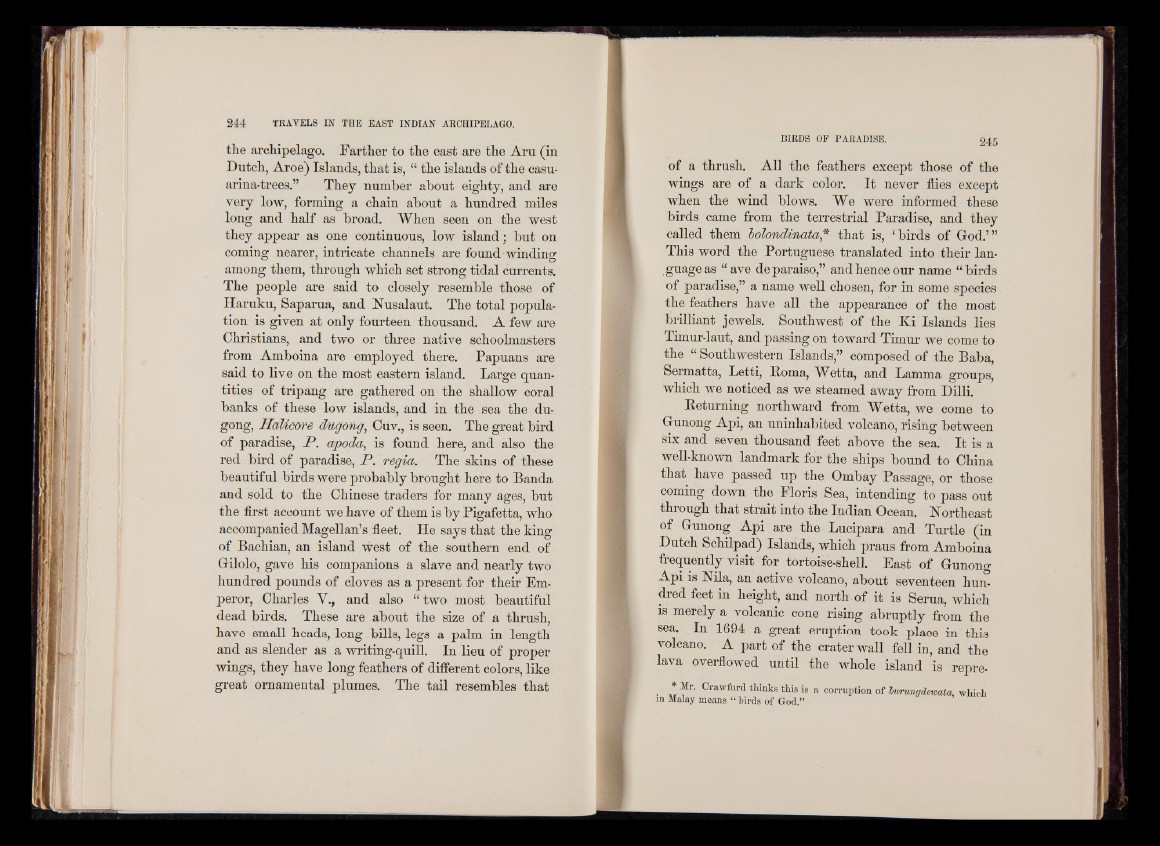
the archipelago. Farther to the east are the Aru (in
Dutch, Aroe) Islands, that is, “ the islands of the casu-
arina-trees.” They number about eighty, and are
very low, forming a chain about a hundred miles
long and half as broad. When seen on the west
they appear as one continuous, low island; but on
coming nearer, intricate channels are found winding
among them, through which set strong tidal currents.
The people are said to closely resemble those of
Haruku, Saparua, and Nusalaut. The total population
is given at only fourteen thousand. A few are
Christians, and two or three native schoolmasters
from Amboina are employed there. Papuans are
said to live on the most eastern island. Large quantities
of tripang are gathered on the shallow coral
banks of these low islands, and in the sea the du-
gong, Halicore cfoigong, Cuv., is seen. The great bird
of paradise, P . a/poda, is found here, and also the
red bird of paradise, P . regia. The skins of these
beautiful birds wore probably brought here to Banda
and sold to the Chinese traders for many ages, but
the first account we have of them is by Pigafetta, who
accompanied Magellan’s fleet. He says that the king
of Bachian, an island west of the southern end of
Gilolo, gave his companions a slave and nearly two
hundred pounds of cloves as a present for their Emperor,
Charles V., and also | two most beautiful
dead birds. These are about the size of a thrush,
have small heads, long bills, legs a palm in length
and as slender as a writing-quill. In lieu of proper
wings, they have long feathers of different colors, like
great ornamental plumes. The tail resembles that
of a thrush. All the feathers except those of the
wings are of a dark color. It never flies except
when the wind blows. We were informed these
birds came from the terrestrial Paradise, and they
called them lolondmata* that is, ‘birds of Cod.’”
This word the Portuguese translated into their language
as “ ave deparaiso,” and hence our name “ birds
of paradise,” a name well chosen, for in some species
the feathers have all the appearance of the most
brilliant jewels. Southwest of the Ki Islands lies
Timur-laut, and passing on toward Timur we come to
the “ Southwestern Islands,” composed of the Baba,
Sermatta, Letti, Roma, Wetta, and Lamma groups,
which we noticed as we steamed away from Dilli.
Returning northward from Wetta, we come to
Cunong Api, an uninhabited volcano, rising between
six and seven thousand feet above the sea. It is a
well-known landmark for the ships bound to China
that have passed up the Ombay Passage, or those
coming down the Floris Sea, intending to pass out
through that strait into the Indian Ocean. Northeast
of Gunong Api are the Lucipara and Turtle (in
Dutch Schilpad) Islands, which praus from Amboina
frequently visit for tortoise-shell. East of Gunong
Api is Nila, an active volcano, about seventeen hundred
feet in height, and north of it is Serua, which
is merely a volcanic cone rising abruptly from the
sea. In 1694 a great eruption took place in this
volcano. A part of the crater wall fell in, and the
lava overflowed until the whole island is repre-
• ^ Crawfurd thinks this is a corruption of hurungdewata, which
in Malay means “ birds of God.”